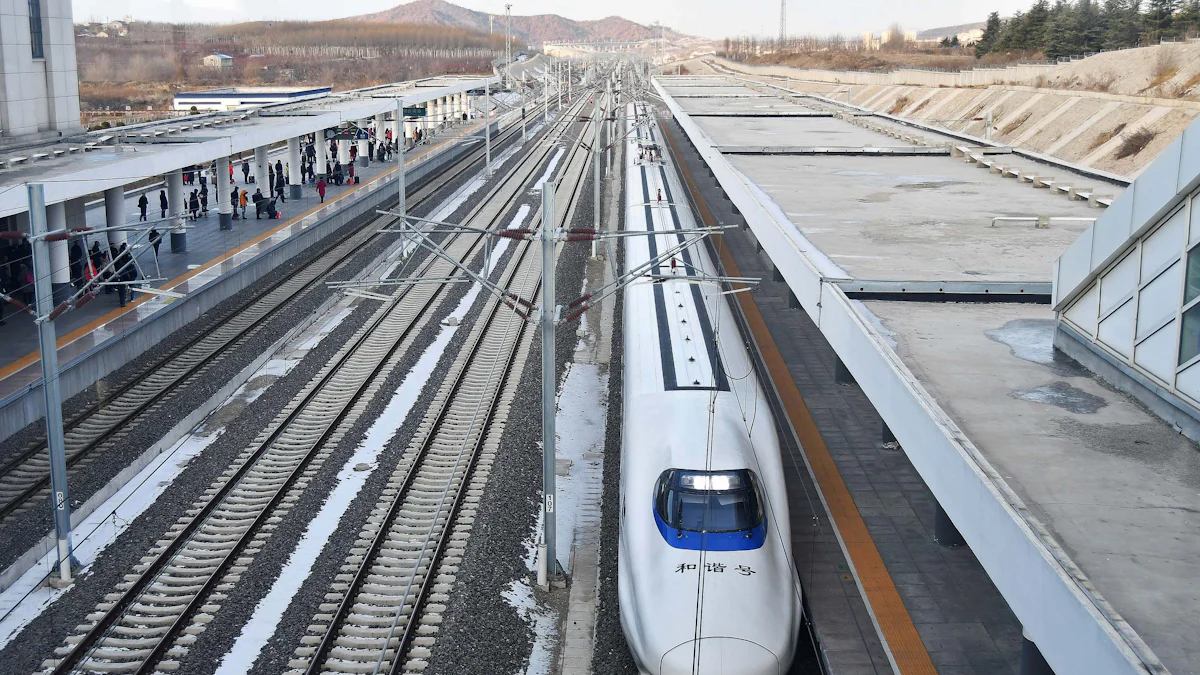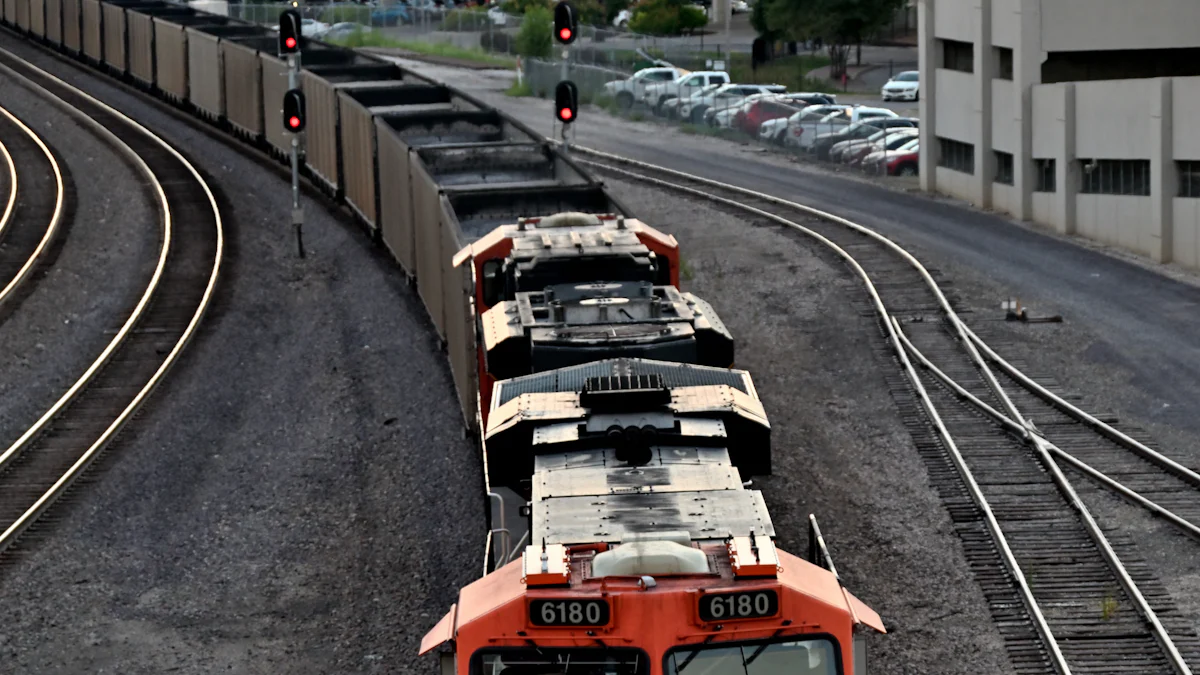The Evolution of Rail Transport: Insights from the China-Europe Railway

Rail transport has a rich history dating back to the early 19th century. The invention of the steam engine revolutionized transportation, leading to the expansion of rail networks worldwide. Rail transport plays a crucial role in global trade by providing efficient and reliable means for moving goods. The China-Europe Railway exemplifies this impact. Connecting over 120 Chinese cities with 219 European cities, it has significantly boosted trade volumes. Trade between China and Europe grew from 4 trillion yuan in 2013 to 7.42 trillion yuan in 2022, highlighting the railway's importance in the rail transport market.
Historical Development of Rail Transport

Early Innovations
The Invention of the Steam Engine
The invention of the steam engine marked a pivotal moment in transportation history. James Watt's improvements to the steam engine in the late 18th century laid the groundwork for its application in railways. The Liverpool and Manchester Railway, established in 1830, exclusively relied on steam power for both passengers and freight. This railway showcased revolutionary locomotives like Stephenson's Rocket, which set new standards for speed and efficiency.
Expansion of Rail Networks in the 19th Century
The 19th century witnessed a rapid expansion of rail networks across the globe. The United States experienced the Golden Age of Railroads from the 1880s until the 1920s. Trains served as the most important mode of transportation during this period due to the absence of cars and airplanes. Railways connected remote areas, facilitated trade, and spurred economic growth. Europe also saw extensive railway development, with countries like Germany, France, and the United Kingdom building comprehensive rail systems.
Modern Advancements
Introduction of Electric Trains
The introduction of electric trains marked another significant advancement in rail transport. Electric trains offered numerous advantages over steam-powered locomotives, including higher speeds, lower operating costs, and reduced environmental impact. The first successful implementation of electric traction occurred in the late 19th century. By the early 20th century, many urban transit systems had adopted electric trains, leading to more efficient and reliable public transportation.
High-Speed Rail Developments
High-speed rail developments represent the pinnacle of modern rail transport innovation. Japan pioneered high-speed rail with the launch of the Shinkansen in 1964, which revolutionized travel by significantly reducing journey times. Other countries followed suit, with France introducing the TGV and China developing an extensive high-speed rail network. High-speed trains now connect major cities across continents, offering a competitive alternative to air travel for medium-distance journeys.
"The China-Europe Railway exemplifies the transformative power of modern rail transport, connecting over 120 Chinese cities with 219 European cities and significantly boosting trade volumes."
The historical evolution of rail transport, from early steam engines to modern high-speed trains, underscores the continuous advancements that have shaped global transportation networks.
The China-Europe Railway: A Case Study

Background and Inception
Initiation of the Belt and Road Initiative
China launched the Belt and Road Initiative (BRI) in 2013. This ambitious project aimed to enhance global trade connectivity. The BRI focused on developing infrastructure and trade routes. Rail transport played a critical role in this initiative. The China-Europe Railway emerged as a flagship project under the BRI.
Key Milestones in the Development of the China-Europe Railway
The China-Europe Railway achieved several key milestones. The first freight train departed from Chongqing to Duisburg in 2011. This event marked the beginning of a new era in rail transport. The network expanded rapidly, connecting over 120 Chinese cities with 219 European cities. By 2022, the railway had facilitated the movement of over 50,000 trains. This growth underscored the railway's significance in the rail transport market.
JUSDA RAIL TRANSPORT
International rail transport - cross-border access to 30+ countries
JUSDA's rail transport services offer several key advantages:
Comprehensive Monitoring and Tracking: JUSDA provides real-time monitoring and tracking of temperature, humidity, air pressure, brightness, and acceleration, ensuring the safe and secure transport of goods.
Fast Customs Clearance: The company employs a fast customs clearance mode, which helps in reducing delays and ensuring timely delivery.
Stable Capacity and Strategic Partnerships: JUSDA maintains strategic partnerships with major rail platforms and has close government relations, guaranteeing stable carriage capacity and reliable service.
Extensive Network and Experience: With over 15 years of rail transport operation experience, JUSDA serves more than 30 countries across Eurasia, handling over 10,000 standard containers annually. The network includes major routes such as China-Europe, China-Russia, China-Central Asia, and China-ASEAN.
Diverse Service Offerings: JUSDA offers full container load (FCL) and less-than-container load (LCL) services, temperature-controlled containers, and customized special trains for both domestic and international routes. They also provide last-mile delivery and energy-saving, emission reduction, green transportation options.
Multimodal Transport: The company excels in international Eurasian sea-rail intermodal transport and domestic multimodal transport by road, water, and rail, enhancing the efficiency and flexibility of logistics solutions.
Specialized Services: JUSDA offers specialized transportation for precision instruments, equipment handling, and hazardous chemicals, catering to specific industry needs.
Innovation and Cost Efficiency: JUSDA focuses on product innovation, developing diversified products, and optimizing standard cost modules to meet diverse market demands, ensuring cost-effective and high-quality rail transport services.
These advantages make JUSDA a reliable and efficient choice for rail transport, capable of handling high-value and special requirement goods across a vast network.
Economic and Trade Impacts
Reduction in Transit Times
The China-Europe Railway significantly reduced transit times. Traditional sea routes took approximately 40 days. The railway cut this time to around 15 days. Faster transit times enhanced the efficiency of supply chains. Businesses benefited from quicker delivery of goods. This improvement boosted trade volumes between China and Europe.
Cost Efficiency and Trade Volume
The railway offered cost-efficient solutions for freight transport. Shipping by rail proved cheaper than air freight. The lower costs attracted many businesses. The railway handled a diverse range of goods, including electronics, machinery, and textiles. Trade volume between China and Europe grew substantially. From 2013 to 2022, trade increased from 4 trillion yuan to 7.42 trillion yuan. The railway's cost efficiency played a crucial role in this growth.
Technological and Logistical Innovations
Advanced Tracking Systems
Technological advancements enhanced the railway's operations. Advanced tracking systems monitored shipments in real-time. These systems provided data on temperature, humidity, and location. Real-time monitoring ensured the integrity of sensitive cargo. Businesses gained greater visibility into their supply chains. This transparency improved overall logistics management.
Intermodal Transport Solutions
The China-Europe Railway integrated intermodal transport solutions. The network connected with sea and road transport. This integration facilitated seamless movement of goods. Specialized containers ensured the safe transport of temperature-sensitive items. The railway also offered full container load (FCL) and less-than-container load (LCL) services. These solutions catered to diverse shipping needs. The comprehensive service offerings strengthened the railway's position in the rail transport market.
The Role of the China-Europe Railway in the Rail Transport Market
Strategic Importance
Enhancing Global Trade Links
The China-Europe Railway has transformed global trade links by providing a faster and more reliable alternative to maritime transport. The railway connects over 120 Chinese cities with 219 European destinations, facilitating smoother trade routes across the Eurasian continent. This extensive network has significantly boosted trade volumes between China and Europe. The railway's efficiency has made it an attractive route for businesses seeking to optimize their supply chains.
Stabilizing Supply Chains
The China-Europe Railway plays a crucial role in stabilizing supply chains. Traditional sea routes often face delays due to weather conditions and port congestion. The railway offers a dependable solution with reduced transit times. Businesses benefit from quicker delivery of goods, enhancing overall supply chain reliability. The integration of advanced tracking systems ensures real-time monitoring of shipments, further contributing to supply chain stability.
Market Dynamics
Competitive Advantages
The China-Europe Railway holds several competitive advantages in the rail transport market. The railway provides cost-efficient solutions for freight transport, proving cheaper than air freight. The lower costs have attracted many businesses, leading to increased trade volumes. The railway handles a diverse range of goods, including electronics, machinery, and textiles. The comprehensive service offerings, such as full container load (FCL) and less-than-container load (LCL) services, cater to various shipping needs.
Government Support and Partnerships
Government support and strategic partnerships have been pivotal in the success of the China-Europe Railway. Close relations with government bodies facilitate fast customs clearance and smooth cross-border operations. The railway has established partnerships with major rail platform companies, ensuring stable capacity and reliable service. These collaborations have strengthened the railway's position in the rail transport market, making it a key player in international logistics.
Challenges and Future Prospects
Operational Challenges
Infrastructure and Maintenance Issues
The China-Europe Railway faces significant infrastructure and maintenance challenges. The extensive network requires regular upkeep to ensure smooth operations. Rail tracks, bridges, and tunnels need constant monitoring and repairs. Harsh weather conditions can exacerbate wear and tear on the infrastructure. Efficient maintenance strategies are crucial for minimizing disruptions in the rail transport market.
Regulatory and Political Hurdles
Regulatory and political hurdles present another set of challenges. The railway traverses multiple countries, each with its own set of regulations and policies. Navigating these diverse regulatory landscapes can be complex. Political tensions between countries can also impact operations. Effective diplomatic relations and international cooperation are essential for overcoming these obstacles in the rail transport market.
Future Outlook
Potential for Expansion
The China-Europe Railway holds significant potential for expansion. The network currently connects 120 Chinese cities with 219 European cities. Future plans aim to extend this connectivity further. New routes could link additional cities and regions, enhancing global trade links. The expansion would support the efficient movement of goods like machinery, electronics, and automobiles. The 2024 forecast indicates that these routes will become even more vital for global trade.
Innovations on the Horizon
Innovations in technology and logistics promise to shape the future of the China-Europe Railway. Advanced tracking systems will continue to evolve, offering even greater visibility into supply chains. Real-time data on temperature, humidity, and location will enhance cargo integrity. Environmental sustainability initiatives will also play a crucial role. The Belt and Road Initiative's green development principles aim to mitigate carbon emissions and biodiversity impacts. The UIC's Low Carbon Rail Transport Challenge aligns with these goals, promoting energy-saving practices in the rail transport market.
"The China-Europe Railway exemplifies the transformative power of modern rail transport, connecting over 120 Chinese cities with 219 European cities and significantly boosting trade volumes."
The future of the China-Europe Railway looks promising, with opportunities for expansion and technological advancements. Addressing operational challenges and regulatory hurdles will be key to realizing this potential. The railway's role in the rail transport market will continue to grow, contributing to global trade stability and economic cooperation.
The China-Europe Railway has transformed global trade and transport by reducing transit times and offering cost-efficient solutions. The railway's strategic importance lies in enhancing trade links and stabilizing supply chains. The market's growth reflects technological advancements and competitive dynamics. Future prospects include expanding connectivity and leveraging emerging technologies. Policymakers must navigate regulatory challenges to maximize benefits. The China-Europe Railway will continue to play a pivotal role in global trade, fostering economic cooperation and regional integration.
See Also
Ready for the Future: Discovering Cutting-Edge Transport Technology in Supply Chains
The Next Era of LTL Freight: An Extensive Examination
Prepared for the Transport Technology Revolution Ahead?
Revolutionary Approaches: Uncovering Supplier Connections in Cross-Border E-commerce
Harnessing Big Data: Transforming Supply Chain Management through Machine Learning
